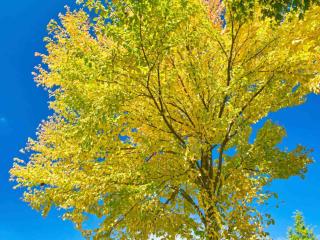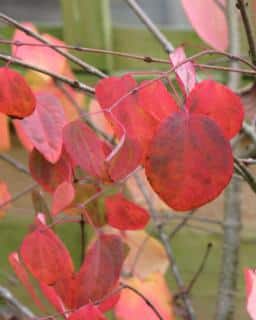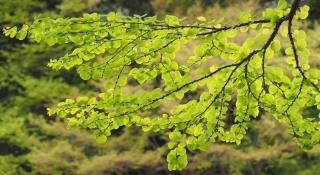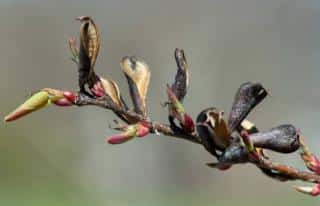

Katsura is an amazing and resilient tree. It will set your garden ablaze in fall with its red-orange hues!
Katsura Key facts
Name – Cercidiphyllum japonicum
Family – Cercidiphyllaceae
Type – average-sized tree
Height – 15 to 50 feet (5 to 15 m)
In the Wild – 100 feet (45 m) if well watered
Exposure – full & part sun
Soil – rich
Foliage – deciduous
Flowering – not remarkable, March-April
Hardiness: very hardy (-30°F or -35°C) – Weakness: not drought-resistant
The katsura tree is quickly becoming a trendy addition to many gardens across the planet. Its history hints at a long-lasting heritage. Learn how to care for it in a few simple steps.
The katsura tree isn’t a demanding tree. The only thing katsura requires is constant soil moisture.

Rich soil will guarantee that the planting is successful.
To make sure the soil stays cool and moist, again, mulch is the way to go.
All soil types will fit the needs of the katsura tree. You can increase fall colors in the following manner:
These katsura planting guidelines go into more detail on the specific steps related to landscaping, planting and transplanting katsura.
On top of abundant watering upon planting, it’s important to water during droughts, even short ones.

Protect against this happening by covering the soil with thick mulch to keep water in. In soil that is excessively wet, though refrain from too mulch that might make the plant suffocate and drown (more information about this in our page about how to plant katsura).
Rich soil is what Katsura trees love most. They’ll thrive when planted with lots of compost and mulch.
After the planting, you can keep the soil both rich and moist with mulch, as mentioned above. However, there are other tricks you can use to keep the soil rich and perfect for your katsura:
There isn’t any particular nutrient that this tree requires more than another. Simply use a fertilizer that is balanced if you must purchase one in a store.
All the usual propagation techniques will be quite successful with Katsura: seed propagation, layering (even air-layering), and cuttings.
Katsura is a species where male and female trees are different. To have viable seeds, you’ll need at least one of each.
Usually, there’s no need to prune the katsura tree.
It grows into a lush, cone-like shape that tends to round off with age.

One particular habit the tree has is that it tends to sprout suckers from the lower portions of the trunk. When left to grow, these turn into secondary trunks. It usually looks very nice, giving the tree a thick, full figure.
If you must prune to reduce the size of your tree, or balance its shape out, then it’s best to do this in spring.
In both Europe and the Americas, there are no major pests or diseases for katsura.
As with most plants (even oak and other trees), rich and humid weather may trigger powdery mildew on your katsura tree leaves.
Deer aren’t interested in the katsura tree.
A few stranded caterpillars might start chewing on the leaves, though.
There are two main types of Katsura tree. These are different species that don’t cross-pollinate into hybrids.
The first and most common one is Cercidiphyllum japonicum. It grows very tall in time, sometimes passing 50 yards (45 meters).
More rare, but equally beautiful, is Cercidiphyllum magnificum. It never grows taller than 30 feet (10 meters). It’s also the variety most suited to training as a katsura tree bonsai.
The botanical name of the katsura tree gives this one away! Cercidiphyllum, when broken down from the original language, means “leaves like those of Cercis”. And indeed, both share the signature round, heart-shaped leaves.
It’s quite easy to tell them apart, though.
Cercidiphyllum, in time, will outgrow Cercis by far.
Leaves are heart-shaped with roundish tips. They start out pale red, shift to bright green, lush green and truly turn into fire come fall with bright yellow, orange and red hues. What’s most surprising is that the leaves often turn pink!
In gardens, katsura tends to stay rather small, but when given time and space it can reach to 50 yards (45 meters) tall!
Katsura is a magnificent addition to every Japanese garden. Its appeal is wonderful in all seasons:
The nickname for this tree is the “caramel tree”. It releases a wonderful scent in fall. It smells like caramelized sugar, cotton candy or that delicious smell wafting out of a Belgian waffle shop.
The scent is due to sugar-rich compounds in leaves breaking down in fall.
The name “katsura” comes from the Japanese city of Katsura. This neighborhood of Kyoto is known for a particular type of flower arrangements, the “Katsura Ko-ryu” school of ikebana, as well as a fabulous palace with beautiful gardens… in which katsura trees grow!
This tree usually starts off with rapid, dynamic growth in the first decade or two of its life.
The shape is very elegant, like a cone with a very pointed tip. It’s similar to the growth of a Ginkgo biloba at that age.

As time passes, most of the new growth is diverted to side shoots that sprout from the tree base. This gives the tree the bearing of a wide old oak tree, similar to those that grow in the magnificent plantations in the SouthEast United States.
It’s difficult to know for sure what the lifespan of the katsura tree is.
Read also
Make sure to plant this tree in a portion of the garden that you tend to pass by. Can’t let that delicious smell come and go unnoticed!